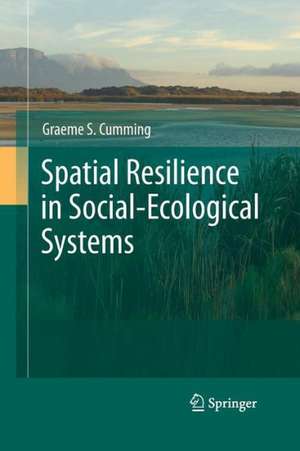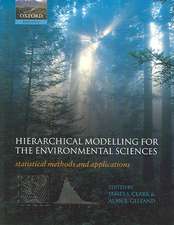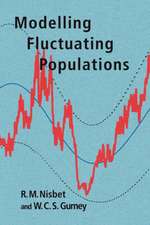Spatial Resilience in Social-Ecological Systems
Autor Graeme S. Cummingen Limba Engleză Paperback – 14 oct 2014
"Graeme Cumming, central in the development of resilience thinking and theory, has produced a wonderful book on spatial resilience, the first ever on this topic. The book will become a shining star, a classic in the explosion of new ideas and approaches to studying and understanding social-ecological systems." Carl Folke, Stockholm Resilience Centre, Sweden
| Toate formatele și edițiile | Preț | Express |
|---|---|---|
| Paperback (1) | 943.25 lei 6-8 săpt. | |
| SPRINGER NETHERLANDS – 14 oct 2014 | 943.25 lei 6-8 săpt. | |
| Hardback (1) | 948.16 lei 6-8 săpt. | |
| SPRINGER NETHERLANDS – 11 feb 2011 | 948.16 lei 6-8 săpt. |
Preț: 943.25 lei
Preț vechi: 1150.31 lei
-18% Nou
Puncte Express: 1415
Preț estimativ în valută:
180.51€ • 196.01$ • 151.63£
180.51€ • 196.01$ • 151.63£
Carte tipărită la comandă
Livrare economică 23 aprilie-07 mai
Preluare comenzi: 021 569.72.76
Specificații
ISBN-13: 9789400790308
ISBN-10: 9400790309
Pagini: 268
Ilustrații: XII, 254 p.
Dimensiuni: 155 x 235 x 14 mm
Greutate: 0.38 kg
Ediția:2011
Editura: SPRINGER NETHERLANDS
Colecția Springer
Locul publicării:Dordrecht, Netherlands
ISBN-10: 9400790309
Pagini: 268
Ilustrații: XII, 254 p.
Dimensiuni: 155 x 235 x 14 mm
Greutate: 0.38 kg
Ediția:2011
Editura: SPRINGER NETHERLANDS
Colecția Springer
Locul publicării:Dordrecht, Netherlands
Public țintă
GraduateCuprins
Foreword.- 1 Introducing Spatial Resilience.- 2 Conceptual background on social-ecological systems and resilience.- 3 A theoretical framework for the analysis of spatial resilience.- 4 Introduction to the use of mechanistic models in studying spatial aspects of social-ecological systems.- 5 Spatial models in ecology and spatial resilience.- 6 Spatial Resilience in networks.- 7 Spatial resilience and landscape analysis.- 8 Spatial resilience, landscape experiments, and fragmentation.- 9 Spatial Resilience and fragmentation in social systems.- 10 Analyzing spatial resilience in case studies of social-ecological systems.- 11 Synthesis and conclusions.- Index.
Textul de pe ultima copertă
Spatial Resilience is a new and exciting area of interdisciplinary research. It focuses on the influence of spatial variation – including such things as spatial location, context, connectivity, and dispersal – on the resilience of complex systems, and on the roles that resilience and self-organization play in generating spatial variation. Professor Cumming provides a readable introduction and a first comprehensive synthesis covering the core concepts and applications of spatial resilience to the study of social-ecological systems. The book follows a trajectory from concepts through models, methods, and case study analysis before revisiting the central problems in the further conceptual development of the field. In the process, the author ranges from the movements of lions in northern Zimbabwe to the urban jungles of Europe, and from the collapse of past societies to the social impacts of modern conflict. The many case studies and examples discussed in the book show how the concept of spatial resilience can generate valuable insights into the spatial dynamics of social-ecological systems and contribute to solving some of the most pressing problems of our time. Although it has been written primarily for students, this book will provide fascinating reading for interdisciplinary scientists at all career stages as well as for the interested public.
In this engagingly crafted book Graeme Cumming provides a novel, and I believe important, synthesis of spatial aspects of the resilience of coupled ecological and social systems.
Robert D. Holt, Eminent Scholar and Arthur R. Marshall Jr.
Chair in Ecology, University of Florida
Graeme Cumming, central in the development of resilience thinking and theory, has produced a wonderful book onspatial resilience, the first ever on this topic. The book will become a shining star, a classic in the explosion of new ideas and approaches to studying and understanding social-ecological systems.
Carl Folke, Science Director of the Stockholm Resilience Centre and
Director of the Beijer Institute of Ecological Economics.
This book is the first broad synthesis of spatial resilience in systems of humans and nature, and exposes the power of spatial approaches for interdisciplinary analyses of resilience. It is a pioneering contribution to a field that is poised for rapid expansion.
Steve Carpenter, Director, Center for Limnology, University of Wisconsin-Madison
In this engagingly crafted book Graeme Cumming provides a novel, and I believe important, synthesis of spatial aspects of the resilience of coupled ecological and social systems.
Robert D. Holt, Eminent Scholar and Arthur R. Marshall Jr.
Chair in Ecology, University of Florida
Graeme Cumming, central in the development of resilience thinking and theory, has produced a wonderful book onspatial resilience, the first ever on this topic. The book will become a shining star, a classic in the explosion of new ideas and approaches to studying and understanding social-ecological systems.
Carl Folke, Science Director of the Stockholm Resilience Centre and
Director of the Beijer Institute of Ecological Economics.
This book is the first broad synthesis of spatial resilience in systems of humans and nature, and exposes the power of spatial approaches for interdisciplinary analyses of resilience. It is a pioneering contribution to a field that is poised for rapid expansion.
Steve Carpenter, Director, Center for Limnology, University of Wisconsin-Madison
Caracteristici
First complete synthesis of ideas relating to spatial resilience Both defines and extends analysis of spatial influences on sustainability Fully interdisciplinary, with examples from ecology, sociology, and economics Highlights key areas for future research as well as recent advances in the analysis of spatial resilience


















